

The Extraordinary Teaching Project: Group Work Strategies from a Group Processes Expert. Working your tone of voice online - Webcredible UX blog. Applying a distinctive and consistent tone of voice to your online communications has many benefits - so long as you make sure that voice doesn't get in the way of web-writing essentials such as usability, accessibility and SEO.

What is tone of voice? If your organisation or brand could talk, it would talk in your tone of voice. It might say different things or speak in a different style to different audiences, but underlying all those communications there is - or there should be - a single personality with a distinctive way of saying things. Personalized Learning Definition. The term personalized learning, or personalization, refers to a diverse variety of educational programs, learning experiences, instructional approaches, and academic-support strategies that are intended to address the distinct learning needs, interests, aspirations, or cultural backgrounds of individual students.
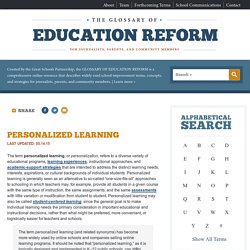
Personalized learning is generally seen as an alternative to so-called “one-size-fits-all” approaches to schooling in which teachers may, for example, provide all students in a given course with the same type of instruction, the same assignments, and the same assessments with little variation or modification from student to student. Personalized learning may also be called student-centered learning, since the general goal is to make individual learning needs the primary consideration in important educational and instructional decisions, rather than what might be preferred, more convenient, or logistically easier for teachers and schools. Debate. 5 Tools and Strategies that Support Group Collaboration Online. Collaboration, where students work towards a common goal, interact and co-create is an essential component of online learning, yet the challenge for the course instructor is how?
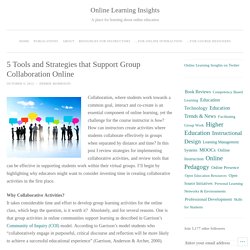
How can instructors create activities where students collaborate effectively in groups when separated by distance and time? In this post I review strategies for implementing collaborative activities, and review tools that can be effective in supporting students work within their virtual groups. I’ll begin by highlighting why educators might want to consider investing time in creating collaborative activities in the first place. Why Collaborative Activities? It takes considerable time and effort to develop group learning activities for the online class, which begs the question, is it worth it?
How-to Make Group Work Collaborative In Online Courses: Four Strategies. “CL (collaborative learning) occurs when small groups of students help each other to learn. CL is sometimes misunderstood. It is not having students talk to each other, either face-to-face or in a computer conference, while they do their individual assignments. Background reading. 12 principles multimedia. High quality collaboration benefits teachers and students. ELI80085. Collab web. Core principles 150226 1. The Power Of Teacher Collaboration. Teaching is simultaneously one of the hardest and one of the most rewarding jobs in the world.
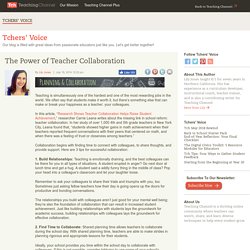
We often say that students make it worth it, but there’s something else that can make or break your happiness as a teacher: your colleagues. In this article, “Research Shows Teacher Collaboration Helps Raise Student Achievement,” researcher Carrie Leana writes about the missing link in school reform: teacher collaboration. In her study of over 1,000 4th and 5th grade teachers in New York City, Leana found that, “students showed higher gains in math achievement when their teachers reported frequent conversations with their peers that centered on math, and when there was a feeling of trust or closeness among teachers.” Research Shows Teacher Collaboration Helps Raise Student Achievement. Research suggests that collaboration with colleagues around student instruction is an essential part of every teacher’s job and results in rising student achievement.

These are the findings Carrie R. Leana, a professor of organizations and management at the University of Pittsburgh, writes about in the fall 2011 issue of the Stanford Social Innovation Review. In her piece, The Missing Link in School Reform, she writes that many so-called reformers argue for increasing human capital — factors such as teacher experience, subject knowledge, and pedagogical skills — in schools. “The power of teacher human capital, the value of outsiders, and the centrality of the principal in instructional practice—form the implicit or explicit core of many reform efforts today.”
These beliefs are not research-based, however. Research Shows Teacher Collaboration Helps Raise Student Achievement. Will blended learning fulfill its disruptive potential? - Christensen Institute : Christensen Institute. Dec 1, 2016 As I mentioned in my last post, the history of education in the United States includes a long list of ambitious programs, initiatives, and reforms that have floundered in producing their promised improvements in student outcomes.
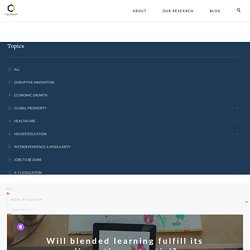
Veteran teachers and school leaders have seen wave after wave of pedagogical, curricular, and policy fads wash over the education landscape with little lasting effect. How Mastery Design Collaborative Helps Schools Redesign their Models to Personalize Learning. How Technology Can Encourage Student Collaboration. Today’s employers say the capacity to collaborate to solve problems is going to be even more important for tomorrow’s workers than content knowledge. And a recent study shows employers are looking for people who can work effectively in teams. Forward-thinking teachers are using technology to promote teamwork and collaborative projects, linking their students to classrooms across the globe. Yet building students’ collaborative skills is tough in traditional classrooms, where a teacher stands at the front of rows of students isolated by desks. Thoughtful use of technology can break this traditional paradigm, but educational technology leader Alan November cautions that the first step is to change old mindsets, not to provide new gadgets.
How Technology is Replacing the Conventional Classroom - TechDecisions.co. The age of traditional teaching methods are in the past now.
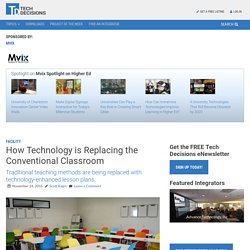
We do not perceive the teaching-learning process as a one way street anymore. On the contrary, it is proven that the knowledge is acquired the best when there is an interaction between the teacher and the students. In order to make that interaction more effective and enhance the process of knowledge acquisition, we use technology. Creating Collaborative Learning Environments with Google Apps for Education - TechDecisions.co. When Erica Hartman first arrived at the West Morris Regional High School District, the schools had no platform for online collaboration.
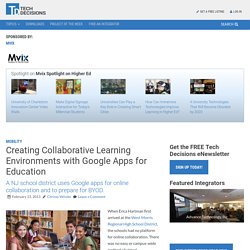
There was no easy or campus-wide method of virtual communication and the district was far removed from the Web 2.0 era where students and teachers work and share ideas in an online format using Web-based tools. “We needed to upgrade the email system and find a way that the teachers could easily collaborate,” says Hartman. “There was no virtual collaboration.”